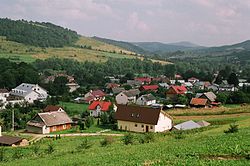Baligród
This article needs additional citations for verification. (April 2010) |
Baligród | |
|---|---|
Village | |
 Baligród | |
| Country | Poland |
| Voivodeship | Subcarpathian Voivodeship |
| County | Lesko County |
| Founded | 1615 |
| Area | |
| • Total | 68.8 km2 (26.6 sq mi) |
| Elevation | 340 m (1,120 ft) |
| Population | |
| • Total | 1,468 |
Baligród [baˈlʲiɡrut] (Ukrainian: Балигород, Balyhorod) is a village in Lesko County, in the Subcarpathian Voivodeship (province) of south-eastern Poland. It is also the seat of the municipality (gmina) called Gmina Baligród. Location: 49°21' N 22°17' E. From 1 January 1999 until 1 January 2002 it was located in Bieszczady County.
History
Baligród is a village situated in the valley of the Hoczewka river, near the Bieszczady mountains. Earlier Baligród was a small town but declined in population over the last century.
The settlement was first mentioned in 1615. It is believed to have been established at the beginning of the 17th century near a castle built by the Bal family. In 1634 the town previously called Balówgród[1] received Magdeburg rights and privileges for markets, fairs and wine storage. Baligród remained in the Bal family until 1770. The town was situated on an often traveled trade route to Hungary. This enhanced opportunities for greater economic development. However the town began to later decline and in 1915 lost its municipal rights.
Between 1914 and 1915, during World War I, Baligród was partially destroyed. During World War II the village was once again partially damaged and many of its inhabitants were killed, including a great many of its Jews. Those Jews that did not manage to escape were rounded up outside of the town and executed. On 6 August 1944 the village was attacked by a strong unit of the Ukrainian Insurgent Army, 42 Poles were killed, and some buildings were burnt.
The soldiers of the Polish Army that were stationed here called the village Diabligród (Devil’s town), because earlier during the occupation the Germans paved the main square with stones taken from the Jewish cemetery. On 28 March 1947, Polish General Karol Świerczewski was killed nearby on a road to Cisna close to Jabłonki.
It is a village with a few stores and homes built around a large square. In the middle of the square is a model of a T-34 tank. The tank was used in skirmishes against the Ukrainian Insurgent Army in the Bieszczady mountains. An earlier monument of a T-70 tank in Baligród was the last one its kind existing in Poland but was transferred to the armour museum of the Centrum Szkolenia Wojsk Lądowych (Land Forces Training Centre) in Poznan.
The ancestors of Michael Schudrich, the Chief Rabbi of Poland, were born in Baligród.
Notable sites
- Catholic church (built in 1877–1879)
- Greek-Catholic church (from 1829)
- Military cemetery (est. 1946–1947, redesigned 1984)[2]
- Bal’s castle (remains of its foundations)
- Ruins of Jewish cemetery
See also
- Komancza Republic (November 1918 – January 1919)
References
- ^ thus the name, Bal (=polish (noble)family) and gord.
- ^ 1999 photo of Soviet partisans' graves in the Baligród cemetery, Photo Archive of the Ghetto Fighters' House


